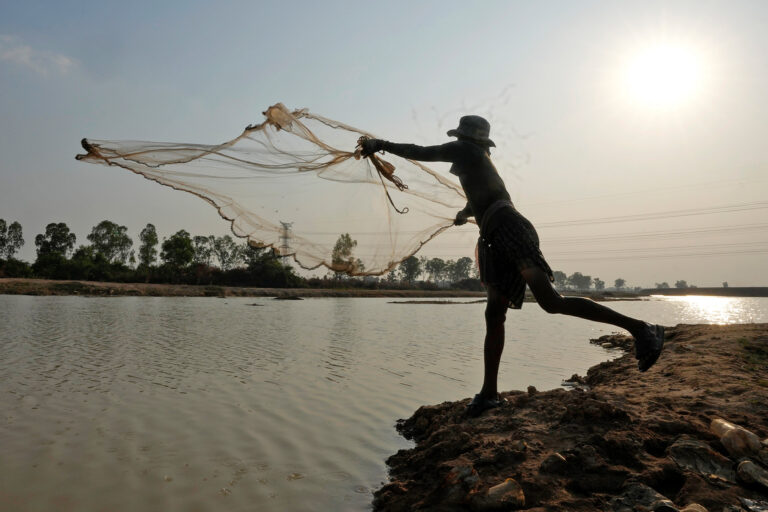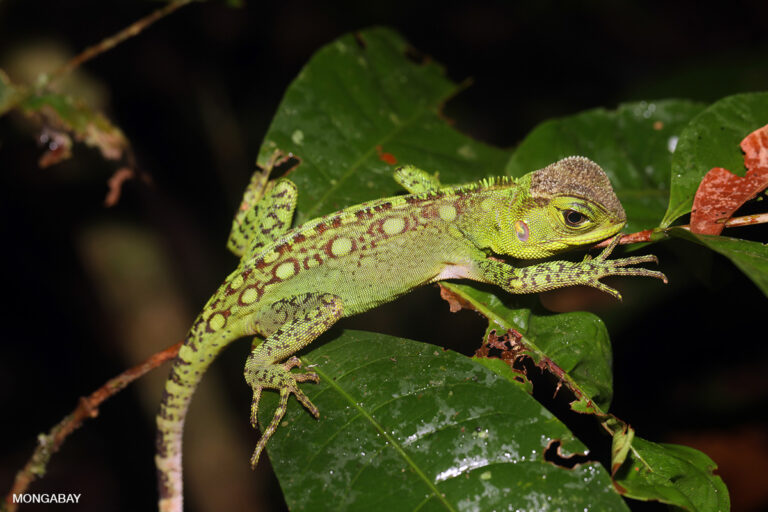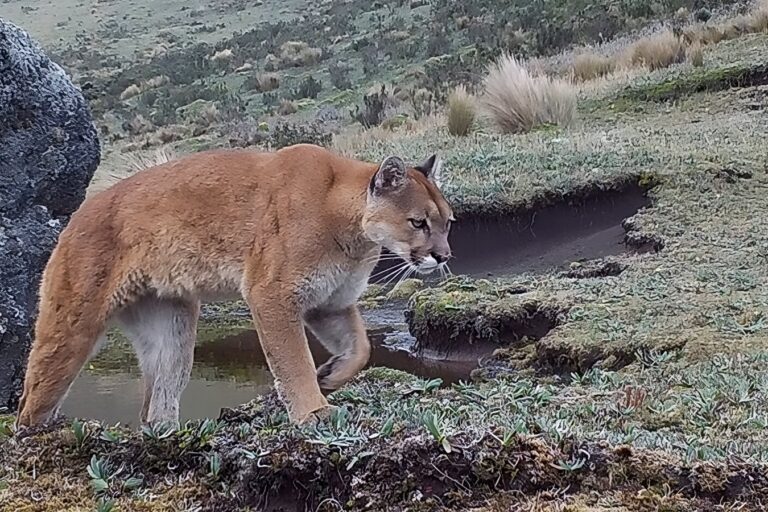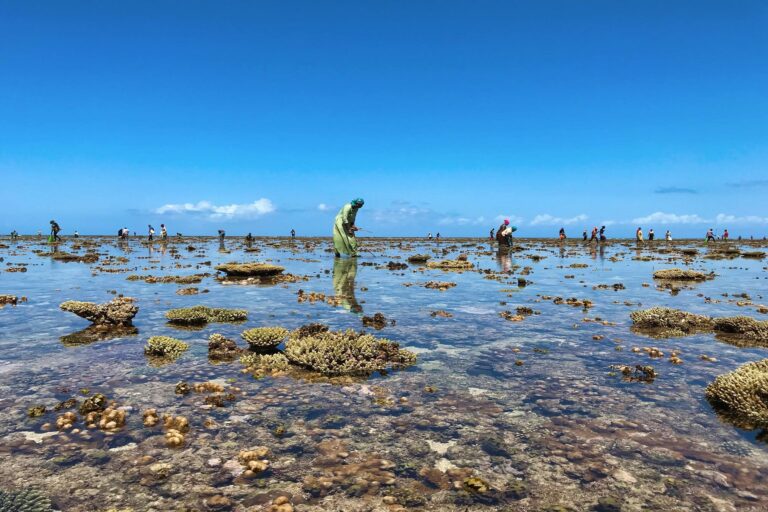
Corey Knowlton posing with a bongo he killed. Photo from Corey Knowlton’s Facebook page.
“After a long conversation with the FBI I have decided to temporarily suspend my activity on this page. I want to thank all of you who have commented [on] this important issue of Black Rhino Conservation.” – Corey Knowlton, Feb 3, 2014.
This was the last post on Corey Knowlton’s Facebook page. Knowlton is the hunter who won the Dallas Safari Club auction on January 11th to kill a Critically Endangered black rhino. All the money—$350,000—will go to a fund to protect rhinos. The plan is that sometime soon—once the paperwork clears the U.S. Fish and Wildlife Service—Knowlton will go to Namibia on a “trophy hunt” (accompanied by a park service official), shoot the designated rhino, and bring the old bull’s hide back home to Texas.
But Knowlton says he was unprepared for the vitriol he received after his name was leaked on the Internet. After all, he insists he is only trying to do a good thing for conservation, and he has the backing of the biggest and most well-known international players in conservation including the WWF, IUCN, the Namibian government, the U.S. Fish and Wildlife Service International, and Save the Rhino.
Knowlton’s story is important to freeze-frame because it spotlights an important ongoing debate among those who don’t want to see big charismatic species go extinct: is it good policy to allow trophy hunters to shoot endangered species if the money goes to conservation? Or is it fatally flawed from an ethical point of view? Does it actually work for the benefit of species and local communities? When this rhino is killed and if the trophy hide is imported back to the U.S., who, besides Corey Knowlton, is to be blamed (or thanked)?
Blowback
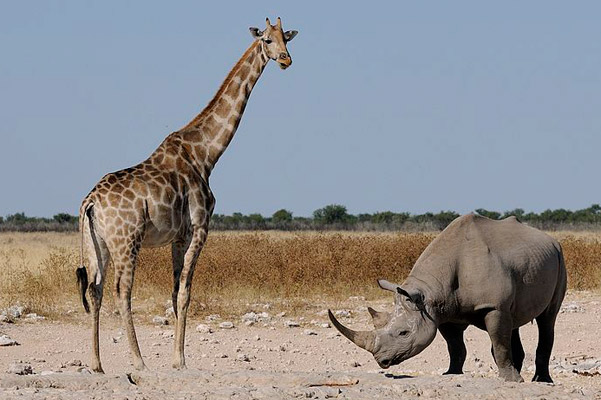
A black rhino and giraffe in Namibia’s Ethosha National Park. It is here where Knowlton will hunt the selected rhino. Photo by: Hans Stieglitz/Creative Commons 3.0.
“I had no idea it would be this visceral,” Knowlton told Piers Morgan in Las Vegas on CNN in January, regarding the backlash he’s experienced. It has been so intense that Knowlton claims he hired private security to protect his family, with the FBI currently investigating numerous death threats and hacktivist plots.
“The Las Vegas Swat team is on alert. I have security going everywhere I go, that’s the hate that I’m dealing with,” Knowlton said on CNN. In offering Morgan an example of the types of threats he, his wife, and two daughters have received, he said “[they] want to kill us all and burn us and make a Saw movie out of us, these are the type of things that I’m getting.”
The fierce controversy over the rhino hunt went viral when Knowlton decided to go public, defending what’s been dubbed a policy of “killing in the name of conservation.”
Supporters say it’s just one rhino identified by Namibian wildlife management officials—an old mean one that is going to die soon anyway. But most importantly, 100% of the profits will go to Namibia’s rhino conservation efforts, which remain among the strongest in the world. The country is home to a total of 1,750 South Western black rhinos and has suffered few poaching events as opposed to many of its neighbors.
Still, animal rights groups and many individuals are furious.
Interestingly, after the leak, Knowlton’s Facebook page exploded, becoming an impromptu platform for the debate between hunters, conservationists, and animal rights advocates. Instead of hiding from the heat, Knowlton encouraged the debate– which he fed several times each day through the offering provocative images, questions, or links. For example, on January 22nd, Knowlton directed his readers’ attention to a passage from conservationist President Theodore Roosevelt’s 1905 book, Outdoor Pastimes of an American Hunter.

A pair of black rhinos in Tanzania. Photo by: Brocken Inaglory/Creative Commons 3.0.
“In a civilized and cultivated country wild animals only continue to exist at all when preserved by sportsmen,” Roosevelt wrote. “The excellent people who protest against all hunting, and consider sportsmen as enemies of wild life, are ignorant of the fact that in reality the genuine sportsman is by all odds the most important factor in keeping the larger and more valuable wild creatures from total extermination.”
Knowlton said he’s motivated by a similar desire to help conservation, telling CNN, “it’s not an egotistical thing, it’s a belief in conservation from me.” Adding, “I’m a member of a group of people who care enough to put their money where their mouth is.”
Defending his love of hunting, he told WFAA news in Texas, “I want to be intimately involved with a black rhino. If I go over there and shoot it or not shoot it, it’s beyond the point.”
In several interviews he explained how hunting connected generations of his family. He told Piers Morgan of growing up poor but looking forward to hunting trips with his father and grandfather: “we looked at hunting as a celebration and a comradery together, as a special time together.”
On his Facebook page, Knowlton also echoed a point given by some conservation researchers that ecotourism can actually be worse for endangered species and their habitats than trophy hunting due to the negative impacts of tourist-required infrastructure. To prove this Knowlton posted an image of a lioness surrounded by a horde of picture-taking tourists under which he remarked, “I am not bashing Eco Tourism at all but this seems excessive. This is from the Masai Mara National Reserve in Kenya.”
Under each of his post hundreds—sometimes over a thousand—comments would be posted in reply to Knowlton and to one another. Those opposed see in Knowlton a poster boy for hunters as “soulless cold zombies” for the moral and ethical lapses of those who say they care about endangered species but support trophy hunting, and for the excesses of rich, white men who travel the globe killing endangered animals for sport.
Media Pile On

Black rhino in a sanctuary being visited by tourists. Photo by: Rob Roy.
The controversy provoked responses from cultural icons as well. Bob Barker, host of the TV Show “The Price is Right” weighed in with a letter distributed by PETA.
“What kind of message does it send when we put a $1 million bounty on one of their heads? These animals are endangered for that very reason: money. What makes you any better than the poachers who kill rhinos to feed their families? At least, they are honest about their less noble motives. You try to dress up greed under the guise of conservation,” Barker wrote. “True conservationists are those who pay money to keep rhinos alive—in the form of highly lucrative eco-tourism—as opposed to those who pay money for the cheap thrill of taking this magnificent animal’s life and putting his head on a wall.”
Comedian and commentator, Steven Colbert, said in October of the hunt, “The Dallas Safari Club says they will save the black rhino by auctioning off the chance to shoot one. It’s like the old saying: If you love something set it free; then when it has a bit of a head start, open fire.”
The hacktivist group Anonymous did more than talk. Using the issue to launch a cyber-attack, the group crashed the Namibian government’s website and the website for the Dallas Safari Club.
“Like those who act against animals without mercy, we will show no mercy to you. It is time to hunt the hunters!” Anonymous said in a press release. “For a long time now we have been watching with horror, the cruelty that some members of the human race seem capable of inflicting upon animals. […] Unspeakable and terrible things happen every second of every day while the whole planet is forced to watch, as these cold hearted soulless zombies cause horrific suffering and death to animals, both common, vulnerable and critically endangered species. The time has come for Anonymous to stand united against such acts. This is not a threat. This is a promise! We are the new face of animal rights”.
 Anti-rhino horn poster from WildAid. The poster reads: Do you want to buy bloody rhino horn? When the buying stops the killing can too. Image courtesy of WildAid. |
In response to Anonymous’ cyber-attacks, Namibia’s Deputy Minister of Environment and Tourism, Pohamba Shifeta, said the hunt was perfectly legal. He added that they would stick by their program, because it brought in revenue for conservation.
“They should also know that with our rhino population, harvesting is part of our program,” he said.
International conservation groups have also stood by the Namibian government and the hunt.
Louis Riboh started a petition on justgiving.com to “outbid the hunter.” After collecting funds, he planned to send them to Save the Rhino so the group could outbid hunters. However he was told by Katherine Ellis, Office and Communications Manager, “Save the Rhino is not opposed to the Dallas Auction, so we would not be prepared to launch a campaign to purchase the permit.” The money was returned to donors.
“There has been a wide range of reaction,” Executive Director of the Dallas Safari Club, Ben Carter, told the Washington Post.
“There’s a lot of people out there, frankly, that are totally without any knowledge of how wildlife and conservation works. We’ve gotten e-mails, phone calls. One e-mail said, ‘If you auction off a permit to kill a rhino, we are going to kill you and your family.'”
Knowlton also framed the debate as a divide between passionate hunters and pragmatic conservation groups on one side and misguided, emotional animal rights activists and sympathizers on the other.
“Animal Rights, please educate yourselves before you save these animals to death (some of you want these animals to go extinct rather than to be under human management) and that’s a real tragedy,” he posted on January 1st.
But is Knowlton correct when he makes such a division, characterizing those who oppose the trophy hunt as bad for conservation?
The situation for rhinos is definitely dire. According to Save the Rhino there are currently an estimated 5,000 rhinos in Africa down from 65,000 individuals in 1970. Ninety five percent of the black rhino population was lost to poachers between 1960 and 1995, a trend that is on the rise again on as rhino horn is currently more valuable per ounce than gold. Rhino horns can be sold on the international black market for anywhere from $50,000 to $300,000. So isn’t every rhino valuable, indeed irreplaceable?
Moral and Ethical Problems

Corey Knowlton with deer he killed. Photo from Corey Knowlton’s Facebook page.
A commenter on Knowlton’s Facebook page wrote, “Murdering endangered animals is wrong…You should burn in hell.” Another adds, “You are a disgrace to the human race.” These types of comments highlight a perspective that killing in the name of conservation is not only bad policy, but ethically flawed.
“The entire idea is shameful, and it is a disgrace,” wrote Humane Society President and CEO Wayne Pacelle last November.
He adds that the latest hunt sets ” a very dangerous precedent,” writing provocatively that “we have to wonder whether the federal government will start issuing permits for trophies of other critically endangered species, such as the cheetah, just because American hunters desire their heads and hides as wall hangings. Where will this stop?”
He adds that “groups like [Humane Society International] are putting money into rhino protection—in the range states and in the states where rhino horn is sold, and we aren’t demanding an opportunity to shoot, capture, snare, terrorize, or baste a rhino. We just want them to live unmolested, protected from human harm and spared from sacrifice for any purpose—spiritual or material.”
Such perspectives are generally shared by other animal rights groups including the International Fund for Animal Welfare.
“Killing animals to save them is not only counterintuitive but ludicrous…We’re talking a highly endangered species, and generating a furor to kill them in the name of conservation is not going to do anything to help them in the long run,” said Jeff Flocken the North American director for the IFAW.
Contrary to Knowlton, Flocken makes the claim that such trophy hunts aren’t as good for wildlife as photo safaris.
“The value of photographic and wildlife-viewing safaris far outweighs the value of trophy hunting.”
But if this is so, why are some major conservation groups still supporting Knowlton and his bid to shoot dead a black rhino?
Bosom Buddies: The Trophy Hunter and the Conservation Establishment
The story of Corey Knowlton reveals some arguably uncomfortable realities about establishment approaches to conservation. Though animal welfare groups might find him and his hunt despicable, Knowlton has the backing of many major conservation groups as well as the Namibian and U.S. governments. Conservation professionals have strong alliances worldwide with pro-hunter groups who share the goal of preserving nature. Hunters argue that “sustainable uses” of nature, including trophy hunting, provides much-needed cash and habitat for wildlife management.
In fact, when Knowlton goes on his trophy hunt, it will be in the company, under the supervision, and with the permission of the Namibian Ministry of the Environment. He has repeatedly claimed that this hunt will be the most regulated, most scientifically-vindicated ever to occur in Africa.
Black rhinos are considered state (in this case Namibian) property, with each rhino identified and their health monitored through an “ear notch” tracking system. As property of the state, the welfare of the rhinos is the responsibility of government officials. Managers must abide by international regulations on the hunting, import, and export of Critically Endangered species as laid out in the CITES convention.
 It’s the rhino’s horns that have pushed many species, including black rhinos, to the edge of extinction. Here a Tibetan monk holds a horn in 1938. Photo by: Ernst Schäfer/Creative Commons 3.0. |
The management of Africa’s rhinos is managed by the IUCN’s African Rhino Specialist Group (AfRSG) and its continental African Rhino Action Plan. In 2004, this group of conservationists ruled that both Namibia and South Africa could sell up to five permits for black rhino hunts each year.
“IUCN has long recognized that the wise and sustainable use of wildlife can be consistent with and contribute to conservation, because the social and economic benefits derived from use of species can provide incentives for people to conserve them and their habitats,” wrote the IUCN in a 2012 document on the sustainable use of rhinos (including trophy hunting).
Moreover, the IUCN’s Sustainable Use and Livelihoods Specialist Group issued a letter last December stating that the auction is “an effective means to raise much-needed money for rhino conservation in a manner fully consistent with Namibia’s successful rhino conservation program.”
On its website, Save the Rhino profiles Namibia’s rhino program, presenting the trophy hunt as part of a bigger plan to conserve the species. Funding for the program (which stems from the U.S. Fish and Wildlife Service and Save the Rhino) goes to anti-poaching campaigns, community conservation programs, ranger training, translocations, and wildlife-based tourism development.
The U.S. Fish and Wildlife Service operates internationally, providing program support abroad and in that capacity makes Corey Knowlton’s hunting trip to Namibia possible. In cooperation with the auction, they provided guidance to the Dallas Safari Club and Dallas Ecological Foundation on specific criteria that must be met for the Service to consider issuing a permit for the importation of a sport-hunted black rhino trophy. Each import permit is evaluated individually on its merits.
“For species protected under the Endangered Species Act, an import permit will be issued if, and only if, we determine that the sport-hunted trophy is taken as part of a well-managed conservation program that enhances the long-term survival of the species,” the U.S. Fish and Wildlife Service wrote last year.
Such efforts are supported by the biggest names in conservation. In 2009, WWF sent a letter to the U.S. Fish and Wildlife Service in support of limited, managed hunting of black rhinos in Namibia.
“WWF believes that sport hunting of Namibia’s black rhino population will strongly contribute to the enhancement of the survival of the species,” the group wrote. Part of the reason why support is high for trophy hunting in Namibia is because of the country’s track record.
“Namibia is just about the only place on earth to have gotten conservation right for rhinos and, incidentally, a lot of other wildlife,” Richard Conniff recently wrote in a New York Times op-ed titled A Trophy Hunt That’s Good for Rhinos.
Conniff states that in the last 20 years, the country has methodically repopulated one area after another as its rhino population has increased. For example Namibia lost just two rhinos to poachers last year, while South Africa lost over a thousand. Conniff credits Namibia’s success to the decision in the 1990s to turn to community-based conservation, run by “black ranchers and herders, some of whom had, until then, also been poachers.”
“The idea was to encourage villagers living side by side with wildlife to manage and profit from it by opening up their conservation lands to wealthy big-game hunters and tourists armed with cameras. The hunters come first, because the conservancies don’t need to make any investment to attract them. Tourist lodges are costly, so they tend to come later, or prove impractical in some areas,” he wrote, echoing Knowlton’s criticisms of ecotourism as high impact in comparison to hunters.
“The theory behind the conservancy idea was that tolerance for wildlife would increase and poaching would dwindle, because community ownership made the illegal killing feel like stealing from the neighbors. And it has worked,” Conniff added. “Community conservancies now control almost 20 percent of Namibia—44 percent of the country enjoys some form of conservation protection—and wildlife numbers have soared.”
It is the Namibian government’s vision that by 2030 all subspecies of the rhino are re-established in viable, healthy breeding populations throughout their former range, and that these populations will be sustainably utilized. Namibia’s overall goal is to raise the population at least five percent each year.
The $350,000 Rogue Rhino (Scientific?) Argument

Female black rhino Photo by: Rhett A. Butler.
This year Namibian officials decided to let the Dallas Safari Club auction off one of its five permits for the first time, in hopes to raise even more money for rhino conservation. The government says the chosen “rogue” male is of advanced age, no longer capable of breeding and has probably killed or injured others in his group.
According to the U.S. Fish and Wildlife Service, the bull’s removal will “stimulate population growth in some areas.” This expert opinion became a part of the science-based argument utilized by Corey Knowlton and the Dallas Safari Club in interviews time and again.
“The Rhino we are going to hunt is a problem animal killing other Rhinos and possibly other animals as well,” Knowlton wrote on Facebook in response to a question about why the government doesn’t simply relocate the old bull. “So the Rhino would absolutely pose a threat to anything in the area he would be relocated to. The problem rhinos in this area are all post breeding very mature males near the end of their life. They could very well die in the darting and transporting process, which by the way is extremely expensive. In addition to this there is a limited amount of habitat suitable for Black Rhinos that is protected well enough to keep him from getting poached once transplanted. So I hope you are getting the picture. The Rhino is old, mean, and has really no place to go because once it would be placed in a new area it would kill the new area’s other rhinos (and probably kill other animals too) or have to be moved to an area where it would be at a greater risk of getting killed by a poacher and absolutely no one wants that..”
Similar reasoning has been echoed by other proponents of the hunt. However many scientists disagree with the logic behind this argument.
“There is no scientific evidence that male rhinos ever become infertile, no matter how old they are,” Dr. Teresa Telecky of Humane Society International stated, adding that removing a rhino that is any less than forty years old “deprives the population of perhaps ten more years of genetic contribution.”
This assessment is shared by The International Rhino Foundation which says on its website regarding the “old bull” rationale that the “facts pertaining to intra-species fighting as a justification for the permit auction are overstated.”
Dr. Ian Redmond, a world-renowned conservationist and biologist, raised another point in an Africa Geographic Editorial on January 23, 2014: “An old male self-evidently has a good immune system and may carry the genes giving immunity to the next epidemic which might kill some apparently stronger young males. In such circumstances an older male might resume breeding and pass on those important genes.”
In fact, the idea that old bulls are bad for rhino populations appears to have been made without understanding the original context, according to an article by Rhishja Cota-Larson. The source of the statement is from a 2009 IUCN publication, but this publication actually refers to rhino density inside fenced sanctuaries, not wild rhinos.
In this story then we have two opposing viewpoints both claiming to have the authority of science on their side. The “science” of rhino reproduction therefore does not seem to be settled. There has been considerable peer-reviewed research that shows trophy hunting does generate substantial revenues, which sometimes benefit local communities, and that private ranching is an important way to keep habitat intact.
“Let’s see if MET [Namibia’s Ministry of Environment and Tourism] has made the right call on holding this auction in Dallas,” Save the Rhino said in a statement.
Killing in the Name of Conservation

Project Rhino memorial to rhinos killed by poachers in South Africa. Photo by: Shaz Lock/Creative Commons 3.0.
It seems ironic that a group called Save the Rhino would be for killing one. But, the group issued a statement, citing financial reasons for why this particular animal has to be killed, i.e. why such ethical lapses may be necessary.
“Couldn’t they get $750,000 without having to suffer an animal being shot? Well, yes…It would be nice if donors gave enough money to cover the spiraling costs of protecting rhinos from poachers,” the group wrote. In response, Knowlton asked rhetorically on his Facebook page why the anti-hunting groups didn’t place any bids.
Calling it an “innovation” within a conservation world suffering from not enough funds, Save the Rhino defended trophy hunting as a way to make money when nature doesn’t “pay to stay.”
“Fundraising for rhinos is hard. We’re not just competing for funds against other endangered species—elephants, tigers, polar bears, pandas—but against cancer charities, children’s charities, or the most recent natural disaster,” wrote the group. “In “An inconvenient truth”, Al Gore asserted that 97% of charitable giving goes to people-related causes and 1.5% to pet charities, leaving only 1.5% for the conservation of our entire planet. Are enough new rhino-focused donors really going to come out of the woodwork to make income from trophy hunting unnecessary?”
As Conniff explains in the New York Times, in this story there may not be any win-wins—only compromises, trade-offs, and hard realities.
“Protecting wildlife is a complicated, expensive and morally imperfect enterprise, often facing insuperable odds. The risk with trophy hunting is twofold: Commodifying an endangered species creates a gray zone in which bad behaviors can seem acceptable, and the public relations disaster this time could hurt Namibia’s entire conservation effort. But so far nothing else matches trophy hunting for paying the bills. For people outraged by this hunt, here’s a better way to deal with it: Go to Namibia. Visit the conservancies, spend your money and have one of the great wildlife experiences of your life. You will see that this country is doing grand, ambitious things for conservation. ”
But many remain unconvinced. At the end of January, Raabia Hawa, KWS Honorary Warden, Founder of Walk With Rangers and an Honorary Warden with the Kenyan Wildlife Service, posted an open letter to Knowlton calling on him to think of the rangers who work every day to save Africa’s vanishing wildlife.
“The wildlife of a nation remains the sovereign property of its people. Would this not mean then, sir, that privatizing such public property would, in fact, be a gross violation of the rights of the African people?” she wrote. “You kind sir, have been duped into believing that your hunt will aid conservation in Africa. It will not. Aside from gaining Namibia huge disrepute, it will go against the very fiber of what we are trying so hard to achieve—the protection and true management of our last wild things.”
But Hawa’s voice is not the one being heeded this time. The bottom line is, like it or not, this is what the partnership between big trophy hunters and conservation looks like: it’s Corey Knowlton being supported by Save the Rhino and other conservation groups whose mission is to protect wildlife, while others cry foul from the sidelines.
Here are the facts: at some point in the future, date unknown, an old bull of over thirty years, who by some good fortune has escaped the violence of poachers for decades, will wake up one last morning, be pointed out by the park guards who have kept him safe and healthy for years, and will be shot dead by an ecstatic Corey Knowlton. Afterwards the dead rhino will be butchered and the heaps of fresh meat will be eaten by the local community. When the thrill of the hunt and the harvesting of the meat is over, the big, prehistoric looking hide will be flown back to Texas as a prize. In return Namibia’s rhino program will receive $350,000, which it will use to pay rangers, support local communities, and boost its rhino populations.
All this will be done in an effort to save rhinos, just not that particular one.
Related articles
Over 1,000 rhinos killed by poachers in South Africa last year
(01/17/2014) In another sign that Africa’s poaching crisis has gotten completely out of control, South Africa lost 1,004 rhinos to poachers last year. According to the numbers released today by the South African Department of Environmental Affairs, 2013 was the worst year yet for rhino poaching in the country with more than 3 rhinos killed every day.
Trophy hunters auction off life of Critically Endangered black rhino
(01/13/2014) The Dallas Safari Club has auctioned off a permit to shoot-and-kill a Critically Endangered black rhino in Namibia for $350,000. The club says the proceeds from the auction will aid rhino conservation, but the move has upset many wildlife organizations and attracted protestors outside the closed-door auction. In fact the issue has become so contentious that the FBI is currently investigating purported death threats against the Dallas Safari Club members over the issue. Currently, less than 5,000 black rhinos survive in the wild today, a drop of 90 percent since 1960 as the species has been decimated by poaching and habitat loss.
Requiem or recovery?: the Sumatran rhino 200 years after its description

(01/08/2014) In 1893, William Bell, a surgeon in the service of the Dutch East India Company stationed in Bencoolen, Sumatra, examined the body of a dead rhinoceros. The animal, a male, was relatively small as rhinoceroses go, measuring only four feet four inches at the shoulder and eight feet five inches from its nose to the tip of its tail. Dr. Bell noted that the animal resembled a large hog and judged it to be a young individual based upon the condition of the bones and teeth.
Consumer report uncovers why people buy rhino horn
(11/26/2013) The rhinoceros is one of the largest and most iconic animals to roam the earth. However, poaching for their horn, erroneously believed to have medicinal value, has led the IUCN Red List to classify three of the world’s five species as Critically Endangered. But, a new consumer report by the wildlife trade monitoring network, TRAFFIC, finds that rhino horn consumers in Vietnam buy the illegal product as much to raise their social status as to attempt to treat a fever or hangover.
New campaign: hey China, stop killing the ‘pandas of Africa’

(10/29/2013) A new public-service campaign in China will ask potential ivory and rhino horn buyers to see the victims of these illicit trades in a new light: as the “pandas of Africa.” The posters are a part of WildAid’s ‘Say No to Ivory and Rhino Horn’ campaign, which was launched earlier in the year.
790 rhinos poached in South Africa this year
(10/29/2013) 790 rhinos have been poached in South Africa this year, nearly a fifth higher than last year’s record toll, reports the Department of Environmental Affairs.
WWF risking Sumatran rhinos by releasing camera trap images, says scientist
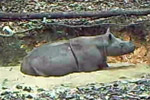
(10/09/2013) On October 2nd, WWF released camera trap videos of Sumatran rhinos surviving in Kalimantan, Indonesian Borneo. The conservation organization had already announced in April that they had evidence of at least one Sumatran rhino in the province, but the new images confirmed what is likely to be a small surviving population. While this is good news for an animal on the edge of extinction, Erik Meijaard, a researcher who has worked in Indonesia for over 20 years, says WWF has made a mistake publicizing the news around the world, noting ‘the last thing those rhinos need is publicity.’
Unlikely success: how Zimbabwe has become a global leader in rhino conservation
![]()
(10/02/2013) With its collapsed economy, entrenched poverty, and political tremors, one would not expect that a country like Zimbabwe would have the capacity to safeguard its rhinos against determined and well-funded poachers, especially as just across the border South Africa is currently losing over two rhinos a day on average. And indeed, without the Lowveld Rhino Trust (LRT), rhinos in Zimbabwe would probably be near local extinction. But the LRT, which is centrally involved in the protection of around 90 percent of the country’s rhinos in private reserves along with conservancy members, has proven tenacious and innovative in its battle to safeguard the nation’s rhinos from the poaching epidemic.
Worst rhino poaching year on record for South Africa
(09/29/2013) At least 688 rhinos have been poached in South Africa this year, surpassing last year’s record of 668 with more than three months remaining in 2013, reports the country’s top environmental official.
Poaching jumps since South Africa announced support for legal rhino horn trade
(09/20/2013) South Africa has experienced an uptick in rhino poaching since Environmental Minister Edna Molewa called for legalizing the rhino trade, reveals analysis by the Environmental Investigation Agency (EIA).
600 vultures killed by elephant poachers in Namibia

(09/11/2013) As the illegal poaching of African elephants and rhinos reaches epidemic levels, other species are also suffering catastrophic losses as a direct result of poachers’ behavior. A recent incident in July, where a poisoned elephant carcass led to the death of 600 vultures near Namibia’s Bwabwata National Park, has highlighted how poachers’ use of poison is now one of the primary threats to vulture populations.
Rhino slaughtered for its horn in city park
(08/13/2013) In another sign that the rhino poaching crisis has gone out-of-control, Kenyan officials announced late last night that a pregnant rhino was poached in Nairobi National Park, which sits on the edge of Kenya’s capital. Home to lions, leopard, giraffes and hippos in addition to rhinos, the park is known for its views of iconic wildlife flanked by Nairobi’s skyline.
The Javan Rhino’s final stronghold

(07/29/2013) August 27, 1883. It’s been called ‘the day the world exploded’. One hundred and thirty years ago this month, the volcanic island of Krakatau (Krakatoa) blew its top. The smoking mountain had given several days warning to the human inhabitants of Java and Sumatra, the closest large islands, but no one could have imagined the intensity of the eruption and the devastation that followed. Several cubic miles of rock and ash – more than half the island – rocketed skyward. The explosion released over 10,000 times the energy of the atomic bomb dropped on Hiroshima and was an order of magnitude more powerful than the eruption of Mount St. Helens. Tsunamis greater than 100 feet high roared over coastal habitats, inundating lowland forests and scouring them of wildlife.







